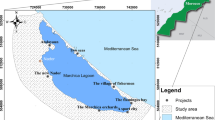Abstract
The plateau east of the Nile Valley at El Minia, Egypt, has been chosen for the siting of El Minia El Gedida city. Problems of underground caves suggested the need for integral geological, geotechnical and environmental hazard studies to examine the suitability of the area as a building site.
Geologically, the area is formed of a thick sequence of Middle Eocene fossiliferous limestones and chalk with some layers of sandy, cherty and marly limestones. These rocks have heterogeneous physical and mechanical properties and fall within the weak to very weak range of limestones. Their mode of failure is almost of the brittle type developing extension, wedge and single shear type fractures. The mechanical properties are controlled by their physical, geological and mineralogical properties. They increase with density and dolomite content and decrease with porosity and calcite content. Empirical equations for some of these relations as well as the relation between field measures of rebound index and compressive strength are presented.
Both regional and detailed structural analyses revealed the presence of major and minor normal faults and fractures trending in NW and NE directions. The NW faults are dominant. They define the topographic escarpments in the area. Most of the caves are aligned along major faults of this trend. Faults, fracture distribution and structural hazard maps of the area are presented. Paleostress tectonic analysis of these fractures suggests that the NW and NE faults are extensional due to tectonic stress which changes from normal to parallel to the Red Sea at different geologic times starting in post Middle Eocene. The similarity of this paleotectonic setting to present Red Sea tectonics points out the possibility of future rejuvenation of these faults.
Topographically, the area lies in shallow surface drainage basins. The topographical risk is increased by fracturing and it should be considered if the area is subjected to a long period of heavy rainfall. Radiometrically, El Minia El Gedida city represents one of the lowest natural radioactivity areas within the safe limits recommended by the International Commission on Radiological Protection (ICRP).
Similar content being viewed by others
References
Abdel Megiud, A. A., El Mettwaly, A. A. and Morsy, M. A.: 1992, Tectonic evolution of continental basalts of Egypt, geochemical evidences, Egyptian Mineralogist 4, 141‐158.
Angelier, J.: 1990, Inversion of field data in fault tectonics to obtain the regional stress: III-a new rapid direct inversion method by analytical means, Geophys. J. Int. 103, 363‐376.
Bishay, Y.: 1961, Biostratigraphic study of the Eocene in Eastern Desert between Samalut and Assuit by the large foraminifera, Third Arab. Petrol. Congr., Alex. 2, 1‐13.
Carisson, A. and Oisson, T.: 1983, Determination of compressive strength of rocks using rebound test hammer and uniaxial compression test, Bull. Geol. Inst., Univ. of Uppsala, New Series 9, 33‐42.
Handin, J.: 1966, Strength and ductility. Geol. Soc. Amer. Memoir No. 97, pp. 223‐289.
IAEA: 1976, Radiometric reporting methods and calibration in uranium exploration, IAEA Technical Report series No. 174, 57 pp.
ISRM: 1979a, Commission on Standardization of laboratory and field tests, suggested methods for determining the uniaxial compressive strength and deformability of rock materials, Int. J. Rock Mech. Min. Sci., 1b, 135‐140.
ISRM: 1979b, Suggested methods for determining properties, Int. J. Rock Mech. Min. Sci. 1b, 141‐156.
Mostafa, M. S.: 1994, Geotechnical and environmental radioactivity of the rocks of El Minia El Gedida city, Egypt, MSc Thesis, Cairo Univ., Giza, Egypt.
NMA: 1991, On the validity of El Minia El Gedida city, Egypt, as a building site, Nuclear Materials Authority, Cairo, Egypt, Internal Report (in Arabic).
Philip, G., El Aref, M., Darwish, M. and Ewais, S.: 1991, Paleoerosion surfaces and Karst manifestation including 'Egyptian alabaster' in Gabel Homert Schoibun-Gabal Sannur area east of the Nile Valley, Egypt, Geol. Soc. of Egypt, pp. 41‐79.
Protodykonov, M. M.: 1969, Methods of determining the shearing Strength of rocks, Israel Program for Scientific Translations, pp. 15‐27.
Said, R.: 1962, The Geology of Egypt, Elsevier, Amsterdam, New York.
Stapledon, D. H.: 1968, Classification of rock substances: discussion, Int. J. Rock Mech. Mining Sci. 5(4), 371‐373.
Wuerker, R. G.: 1959, The shear strength of rocks, Min. Eng. 11(10), 1022‐1026.
Author information
Authors and Affiliations
Rights and permissions
About this article
Cite this article
Abdel-Meguid, A.A., Fayed, L.A., Mostafa, M.E. et al. Geotechnical and Environmental Hazards in Desert New Cities: A Case Study of El Minia El Gedida Site, Egypt. Natural Hazards 17, 47–67 (1998). https://doi.org/10.1023/A:1007923507801
Issue Date:
DOI: https://doi.org/10.1023/A:1007923507801



